What to Wear Hiking in Fall & Tips to Stay Cozy and Safe on the Trail
This post may contain affiliate links.
Fall is a great time to hit the trail! The temperatures have cooled down, the crowds have subsided, and the autumn leaves are putting on a stunning show of color! Before you lace up your hiking boots, here are some tips on how to prepare for this new season of hiking.
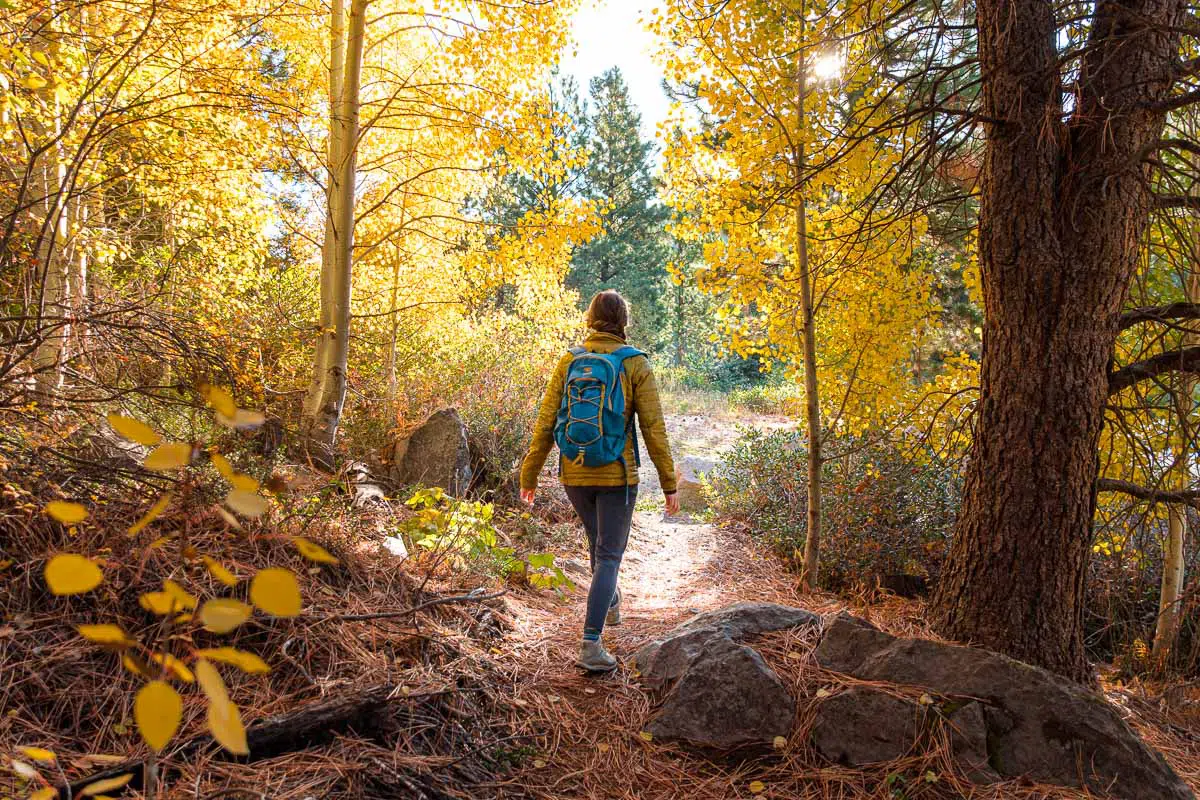
While we hate to pick favorites… fall is our favorite season for being outdoors. There, we said it. After a hot & sticky summer, that first cool day of fall feels like an absolute breath of fresh air! Whether it’s going on a fall day hike or packing up for a fall camping trip, there’s a lot of reasons to get excited about being outside this autumn.
What’s great about fall hiking
- Fall foliage! The seasonal changing of the colors is one of the most spectacular events in the natural world and it happens every year!
- Cooler daytime temperatures means your hike doesn’t need to become a total sweatfest!
- The summer crowds have thinned out considerably.
- The bugs have all but disappeared!
But there are a few challenges to watch out for as well…
- Shorter days means limited daylight hours for hiking.
- The weather can be more unpredictable. Rain, wind, and possibly snow.
- Start of the hunting season means greater precautions need to be taken in some areas.
Below, we share our top tips to help you get the most out of the fall hiking season. Suggestions on what to wear, what to pack, and how to be prepared while out on the trail.
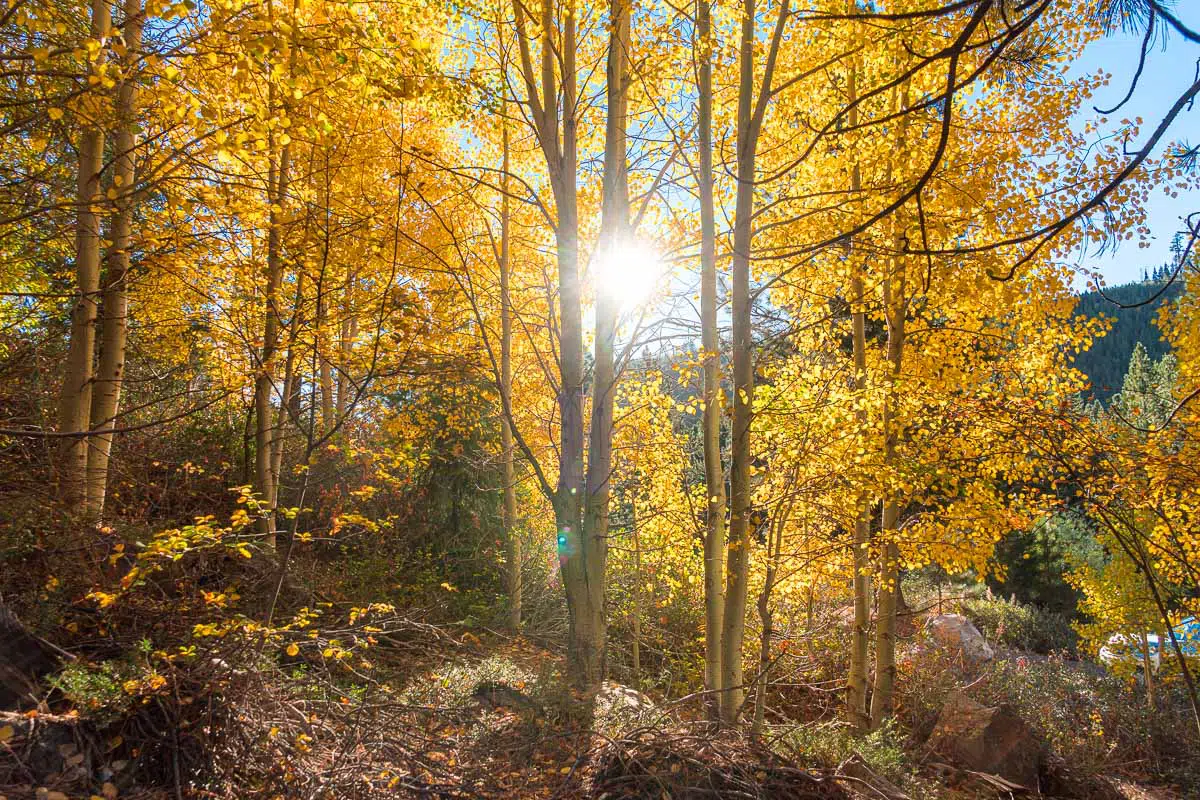
Fall hiking resources
Fall Foliage Map: If you are looking to catch the fall foliage season, the best place to start is the Smoky Mountains Fall Foliage Map (it covers the whole US—not just the Smokys!). This is an interactive, predictive map that is updated each year based on the weather conditions experienced during the spring and summer months. And should give you a good sense of when your region will be in full colors.
AllTrails: Want to find a hike near you with some spectacular fall foliage? The AllTrails app and website is a great resource. Not only can you explore nearby trails, but frequent user reviews and photos can give you a good sense of what the conditions are like out there. A review from a day or two ago might let you know if the foliage is not quite there or approaching its peak.
Seek App: Want to learn more about the different plants and wildlife you come across on the trail? (Like what type of leaf is this?) Then you need to download the Seek app! We love it. Using your smartphone’s built-in camera and the app will automatically try to identify plants and animals down to the particular species.

How to stay safe when hiking in the fall
Many of our hiking suggestions are applicable to any time of year, but we wanted to highlight a few areas that are particularly relevant to hiking during the fall.
10 essentials of hiking
Regardless of what time of year you’re hiking, it’s a good idea to familiarize yourself with the 10 hiking essentials. The list is applicable to all types of hikes, day hiking, and multi-day backpacking trips, and is designed to be adapted to any season. It covers everything you should carry with you while hiking so you can be prepared for the unexpected.
Use offline GPS navigation
Trail conditions during the fall can change quickly. A carpet of fallen leaves, heavy rain, or even an early snowstorm can quickly obscure a once-obvious trail. That is why using an offline map with GPS navigation is a very good idea.
We use the AllTrails app with the Plus subscription to download our route for offline use ahead of time. This way, even when we’re out of service, we have access to our route, and our phone’s GPS navigation overlays the map so we can double-check our position relative to our planned route. Additionally, you can print a paper map of any trail route, so you have a backup if your phone or GPS device fails for some reason.
Check the weather forecasts
Fall weather can be quite unpredictable. Not only is it important to check your local forecast (we use the Darksky app) but if you’re heading into the mountains you will want to get an accurate forecast for what the weather might be like at higher elevations.
For this, we use Mountain Forecast. This helps us get a better picture of the type of weather and temperatures we might encounter during a hike, so we can pack accordingly. It might be in the 70’s at the trailhead, but in the 30’s at the summit.
Pack a headlamp
As the days grow shorter it’s more important than ever to pack a headlamp with you. Spend a little too much time soaking in the fall foliage, and you might unexpectedly find yourself out after sunset. It’s always a good idea to have a fully-charged light source with you, and doubly so when the sun sets earlier and earlier each day.
Be aware of hunting season
Throughout much of the country, fall is the start of hunting season. So you will want to be aware if your hike could be affected by this.
- Double check the hunting regulations in your area so you are aware of whether you’re likely to encounter hunters on your hike.
- Bright, visible colors like orange, yellow, red, and pink are best.
- Keep your dog (if allowed on the trail) on a leash and ideally, have them wear a brightly colored harness or vest pack.
- Make some noise on the trail—talking with your hiking partner or singing will help alert hunters to your presence.
For more information, check out the article Staying Safe During Hunting Season by the Washington Trail Association.

Hydration & food
- Proper hydration helps your body with temperature regulation, so you’ll stay warmer. Be sure to drink water frequently on your fall hikes. Personally, we like to store room temperature water in our insulated bottles so that we don’t have to drink cold water on chilly hikes.
- Pack plenty of snacks! Not only will snacks help keep your energy levels up, but they will also fuel your body’s “furnace” and help keep you warm. Aim for a mix of carbs for quickly accessible energy and fats for a longer burn. Protein will be helpful for recovery, so have a protein rich snack ready for the end of your hike. If you need ideas, here are our favorite hiking snacks and trail mix recipes to stash in your backpack.
- Once you stop moving, your core body temperature will begin to drop. If you know that you’ll want to spend some time enjoying the scenery at the top of your hike, pack something warm to enjoy to help keep you cozy while you soak in the views. Soup stored in an insulated jar or quickly made in a JetBoil makes for a warming mid-hike meal, or simply pack along coffee, tea, or hot cocoa in an insulated tumbler to sip on while you’re stopped.

Fall hiking outfit & layering tips
Fall is one of those seasons where you can easily expect to experience a little bit of everything all in one day: mornings are chilly, daytime temperatures can still climb into the 60’s and 70’s, the wind can pick up, it can rain on and off, and at higher elevations, a little bit of snowfall isn’t out of the question.
So, what do you wear hiking in the fall that will keep you comfortable if you encounter all of this in one day? The answer, my friends, is LAYERS! Once you have mastered the technique of layering, you’ll know how to manage your body temperature on any hike and be comfortable throughout the day—regardless of the weather.
In this section, we dive deep into layering, how it works, and give you a few recommendations from our personal experience. If you’re hiking later in the season or in particularly cold weather, you may want to check out these winter hiking layering tips to learn how to kick your layering system up a notch.

Base layer
This is your next-to-skin layer, which will wick away moisture to keep you dry (and therefore warmer). This layer should be made of synthetic material or wool—not cotton, which is known to hold moisture and can cause you to become chilled.
We really like having a short-sleeve (or tank top) as our base layer for fall hiking. Temperatures in the middle of the day can get warm, and if you’re doing something active it’s nice to have the option to strip all the way down to a t-shirt.

Smartwool 150 Shirt
(men’s & women’s)
If you want to take advantage of the performance properties of wool (wicking, fast-drying, odor-resistant), then these Smartwool t-shirts are a great choice. Slim fitting, quality construction, and surprisingly affordable for merino wool. We own a few of these shirts and use them as base layers all the time.

Patagonia Capilene Trail Shirt
(men’s & women’s)
The Capline Trail shirt is available in a short sleeve or long sleeve version, for both Men and Women. We have owned a variety of Capilene products from Patagonia over the years and have loved all of them. The fabric has the natural feel of cotton, but the active performance of synthetic.

Vuori Strato Tech T-Shirt
(men’s)
The Strato Tech t-shirt by Vuori is made with synthetic fabric with similar performance properties as wool. But what makes this shirt—and all of Vuori’s products—so spectacular is the fabric’s incredible softness. It’s out of this world comfortable. Seriously, you’ve got to feel it to believe it.

Mid layer
The middle layer of a fall hiking outfit is a lightweight warm layer, such as a long sleeve shirt or light fleece. It should be able to fit over your base layer comfortably, and not be too bulky so it will fit under your insulating layer without restricting your movement.

REI Co-op Sahara Thermal Shirt
(men’s & women’s, plus-size, & tall)
Perfect for the trail or around town, the Sahara Thermal Shirt blends casual style with active performance. As a fall mid-layer, this button-down flannel shirt is perfect because it’s easy to put on or take off, and it’s moisture-wicking and breathable. Seamless transition from the trail to grabbing a beer.

Vuori Halo Hoodie (women’s)
This moisture-wicking hoodie comes in a full zip and pull-over version and is SO soft. It’s the perfect weight for fall days where a single t-shirt might not cut it, but the temperature hasn’t dropped too much.

Vuori Ponto Performance Crew Sweater (men’s)
This lightweight, long-sleeve sweatshirt by Vuori is another great mid-layer option. The synthetic fabric has all the active performance you’d expect plus a subtle elasticity, that allows for total freedom of movement.
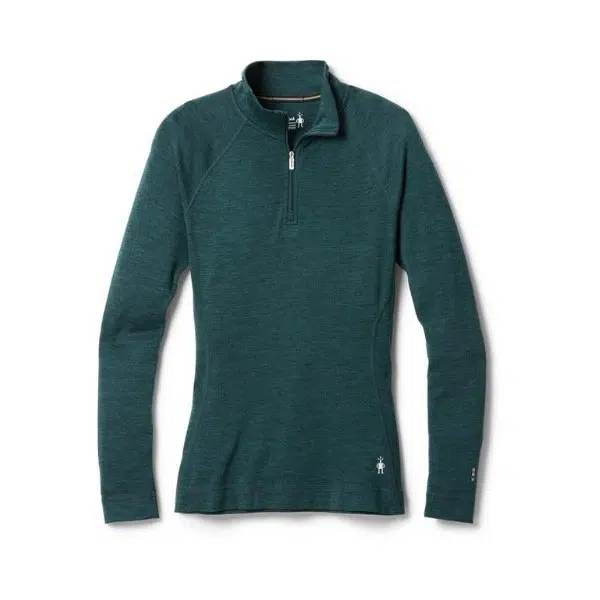
Smartwool Merino 250 Quarter Zip (men’s & women’s)
While wool is usually used as a next-to-skin base layer in winter hiking outfits, it makes a great mid-layer for fall hiking, too! We own a couple of these quarter zips from Smartwool and love the ability to open them up a little to regulate our body temperature. Basically, it can go from being as open as a polo shirt to as snug as a turtle neck just by adjusting the zipper.

Patagonia Better Sweater (men’s & women’s)
This super cozy fleece sweater from Patagonia is made from 100% recycled polyester. This is one of Michael’s favorite fall sweaters. It’s a little too warm/bulky to be worn under an insulated puffy, but he loves pairing it with an insulated vest.

Insulating layer
Your insulating layer will help trap and retain your body heat, keeping you nice and toasty. Unless it’s really cold out, you likely won’t wear this layer while you’re hiking (at least not for long). However, you will want to throw this on as soon as you take any breaks so your core temperature doesn’t drop too much while you aren’t moving and generating heat.
This layer is typically a jacket or hoodie insulated using down (look for RDS-certified down) or a synthetic insulating material like Primaloft.

REI Co-op 650 Vest (men’s, women’s, plus-sizes):
Vests are a great insulating layer for fall when the temperatures are cool but not freezing cold. You can retain a lot of freedom of movement in your arms while keeping your core warm. Michael bought this REI 650 Vest last year and has been loving it. The 650 down fill keeps me toasty, the recycled nylon feels great, and the large baffled stitching has a great vintage look.

Patagonia Nano Puff Jacket (men’s & women’s)
Patagonia’s Nano Puff Jacket is a great mid-layer option that features synthetic Primaloft insulation. I like that it’s not as puffy as a down jacket, so it fits better under other layers and packs away easily when you’re not wearing it.
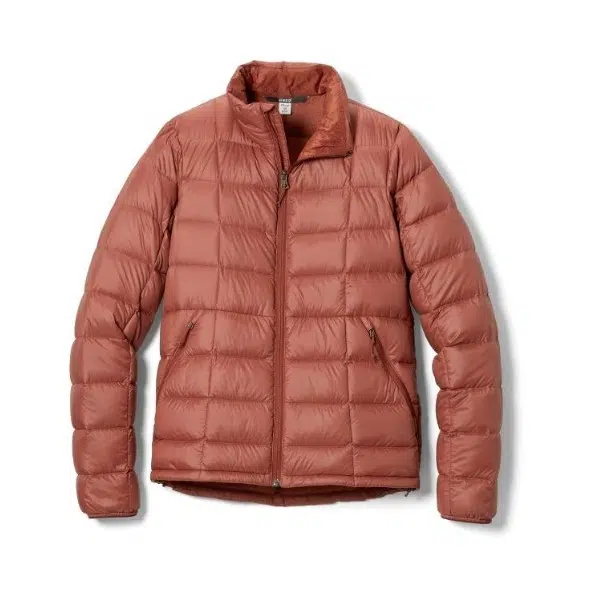
REI Co-op 650 Down Jacket 2.0 (men’s, women’s, plus-sizes, tall sizes)
As far as down jackets are concerned, the REI Co-op 650 is an incredible value. It’s filled with 650 RDS-certified down so it’s warm and insulating, but it comes with a lower price tag than many other down jackets on the market.
Water & windproof outer shell
Your outer layer will keep you (and the rest of your layering system) dry in the event of rain and will help trap in heat and keep out the wind. This layer generally consists of a rain jacket and a pair of rain pants that are stashed in your daypack until needed.

REI Rainier Rain Jacket (men’s & women’s, plus & tall sizes)
The Rainer Rain Jacket from REI is a fully waterproof jacket that features a 2.5 layer breathable fabric (REI’s version of GORE-TEX). It features a hood that can be rolled up into the collar and pit zips for ventilation. REI offers a men’s and women’s size jacket in a wide range of sizes including men’s tall, and women’s long and plus-size.

Fall hiking pants
On a fair-weather day, a pair of comfortable, breathable, water & wind resistant pants might be all you need. If it’s particularly cold, you might consider wearing a base layer underneath your pants. If there’s a high chance of rain, you may want rain pants.

Crossover Trail High-Rise Leggings (women’s & petite, tall and plus-sizes)
I’ve been loving these fleece lined leggings for cooler hikes! They are made of moisture wicking, 4-way stretch fabric and are lined with a brushed fleece fabric that is so soft and cozy–without adding any bulk! They are also designed with a high waist, so they do a good job staying put.

REI Co-op Flash Hybrid Leggings (women’s & plus-sizes)
These quick-dry, breathable, and moisture-wicking leggings are a little more durable than your typical yoga-style leggings, while still being stretchy and comfy on the trail. However, they don’t have any water resistance, so for hikes where the trail may be wet, choose a pair of leggings that are made of DWR materials like these North Face Winter Warm Tights.
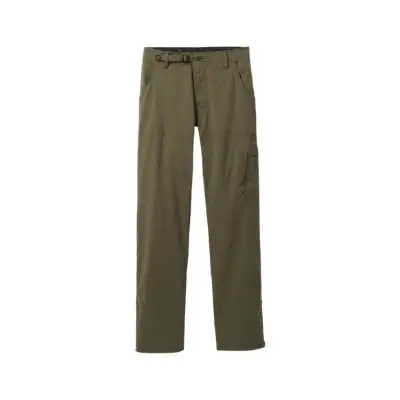
prAna Stretch Zion Pants (men’s)
These lightweight, breathable pants are Michael’s go-to favorites for cool-weather hiking. They’re super comfortable, slightly stretchy, and look just at home in town as they do on the trail. If it’s particularly cold out, he’ll wear a Smartwool base layer underneath. They also have a DWR finish, which gives them a little bit of water resistance.

REI Co-op Lined Sahara Pants (men’s, women’s, plus-sizes)
If you tend to run a little cold or plan to hike in chillier temperatures and prefer a looser-fitting pant, these lined Sahara pants by REI are a great pick! Featuring breathable, water-resistant, stretchy fabric, and a soft fleecy lining, these hiking pants are very versatile. A big perk of these pants is the slightly elastic waistband, which keeps the them from gapping in the back.

REI Rainier Rain Pants (men’s & women’s)
Our top pick for rain pants is REI’s Rainier pants for two reasons— 1) they are durable and waterproof so they get the job done, and 2) the legs are full zip, so you can take them on and off without taking your hiking boots off (or having to navigate muddy boots through the legs). However, they are a little on the “crinkly” side—as most rain pants are. We found that the REI Talusphere Rain Pants are a little less so, though the trade-off is they aren’t full zip.

Fall hiking footwear
Wool Socks
Wool is the gold standard in hiking sock materials. It keeps your feet warm while drawing away moisture that can cause blisters. It’s important to make sure that your fall hiking socks aren’t so cushy that they cause your boots to fit too snug, which can decrease your circulation and cause your feet to get cold. We highly recommend that you bring at least one pair of extra socks on your fall hikes to change into in the event your first pair gets wet!
Waterproof shoes or boots
All it takes is a little bit of rain to turn a perfectly passable trail into a mud field, which is why you might want to consider upgrading your fall hiking footwear. Picking up a pair of waterproof hiking shoes or boots means a little rain won’t spoil your hike. They also tend to be a little more thermally insulating, a nice plus to keep you from getting chilly toes!
Leave No Trace Tip: The wet conditions of autumn can cause mud and puddles on the trail. While your first response might be to avoid them, going around puddles and mud can contribute to trail erosion and damage the surrounding vegetation. Wherever possible, step through puddles—this is where it’s important to wear waterproof footwear when hiking in the fall!

Day packs
The most important part of the “layering” system is having a backpack to store all your extra layers (along with your other hiking essentials). Without one, you’ll just end up wearing all the layers all the time. It is essential you remove and add layers to match your current level of exertion.
When selecting a backpack for shoulder-season hiking, look for one with a decent amount of storage space (20-40 liters), and easy-to-access compartments, and waterproof fabric. If your favorite daypack isn’t waterproof, you can buy a separate raincover here.

Fall hiking outfit accessories
Beanie / Hat: The easiest (and least bulky way) to increase your perceived warmth is to put on a hat. A cozy wool beanie is a must-have fall hiking accessory. Even if you don’t think you’ll need it, put it in your backpack. We’ve never regretted having packed one!
Gloves: While full-blown winter mitts might not be necessary for a fall hike, a pair of thin gloves can really help take the edge off of a chilly morning. We use either Smartwool glove liners or REI’s PolarTec Stretch gloves during the shoulder season.
Buff/Scarf: Another great way to add a lot of warmth without adding another bulky layer is to use a buff. If you lived through 2020 then I’m sure you are very familiar with these things. But they are one of our fall hiking essentials.
Sunglasses: As we get deeper into autumn, the sun starts to sit lower and lower on the horizon. So it is more important than ever to pack a pair of polarized, UV-blocking sunglasses.



